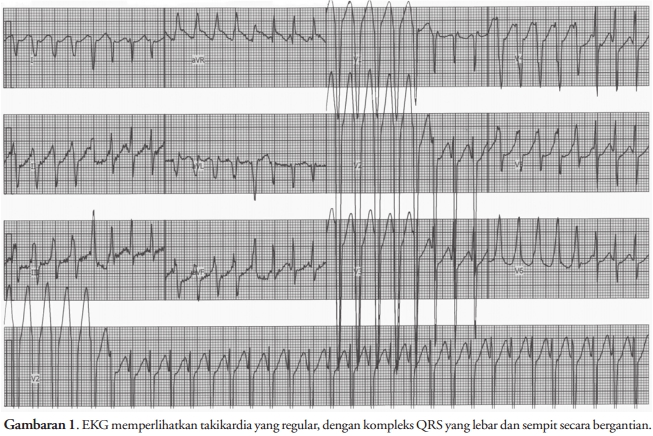Takikardia dengan QRS lebar dan sempit
Abstract
Pasien datang dengan keluhan berdebar berulang, rekaman EKG terlihat seperti pada Gambar 1. Bagaimana mekanisme takikardia dengan QRS lebar dan sempit? Perhatikan segmen EKG yang memiliki kompleks QRS sempit. Tampak QRS reguler, dan tidak terlihat adanya gelombangP maupun pseudo r pada setiap antaran (lead). Gambaran yang cukup khas untuk suatu atrioventricular reentrant tachycar-dia (AVNRT).

Downloads
Download data is not yet available.
References
Lehmann MH, Denker S, Mahmud R, Addas A, Akhtar M. Linking: A dynamic electrophysiology phenomenon in macroreentry circuits. Circulation. 1985; 71: 254 – 264
Tomcsanyi J, Somloi M, Bozsik B, Rohla M. Wide and narrow QRS complex tachycardia with identical heart rates: what is the mechanism? PacingClin Electrophysiol. 2005; 28: 568– 70
Tomcsanyi J, Somloi M, Bozsik B, Rohla M. Wide and narrow QRS complex tachycardia with identical heart rates: what is the mechanism? PacingClin Electrophysiol. 2005; 28: 568– 70
Views & Downloads
Abstract views: 6370
PDF (Bahasa Indonesia) downloads: 2072
PDF (Bahasa Indonesia) downloads: 2072
How to Cite
Yuniadi, Y. (1). Takikardia dengan QRS lebar dan sempit. Indonesian Journal of Cardiology, 28(2), 28:iii. https://doi.org/10.30701/ijc.v28i2.262
Section
Forum Aritmia
Authors who publish with this journal agree to the following terms:
- Authors retain copyright and grant the journal right of first publication with the work simultaneously licensed under a Creative Commons Attribution License that allows others to share the work with an acknowledgement of the work's authorship and initial publication in this journal.
- Authors are able to enter into separate, additional contractual arrangements for the non-exclusive distribution of the journal's published version of the work (e.g., post it to an institutional repository or publish it in a book), with an acknowledgement of its initial publication in this journal.
- Authors are permitted and encouraged to post their work online (e.g., in institutional repositories or on their website) prior to and during the submission process, as it can lead to productive exchanges, as well as earlier and greater citation of published work (See The Effect of Open Access).



















